Workplace Law Case Study: Employee Rights and Share Scheme Access
VerifiedAdded on 2023/06/12
|7
|1890
|401
Case Study
AI Summary
This case study examines a workplace law scenario involving Max and Creative Advertising Ltd, focusing on the legal rights to an employee share scheme. The analysis addresses whether Max has an immediate right to the share scheme as promised and whether the company engaged in misleading conduct. Relevant laws such as the Fair Work Act 2009, Independent Contractor Act 2006, and Australian Consumer Law are applied to determine the nature of the working relationship and the fairness of the contract. The study references key cases like Stevens v Brodribb, Hollis v Vabu, and Fair Work Ombudsman v Happy Cabby to support the arguments. The conclusion asserts that Max has a legal right to the share scheme based on the initial promise and the employer's failure to disclose the scheme's conditions, citing section 340(1) of the Fair Work Act and section 18 of the ACL. However, if the promise was made six months after working, Max would be expected to understand the company's requirements and would not have an immediate right.
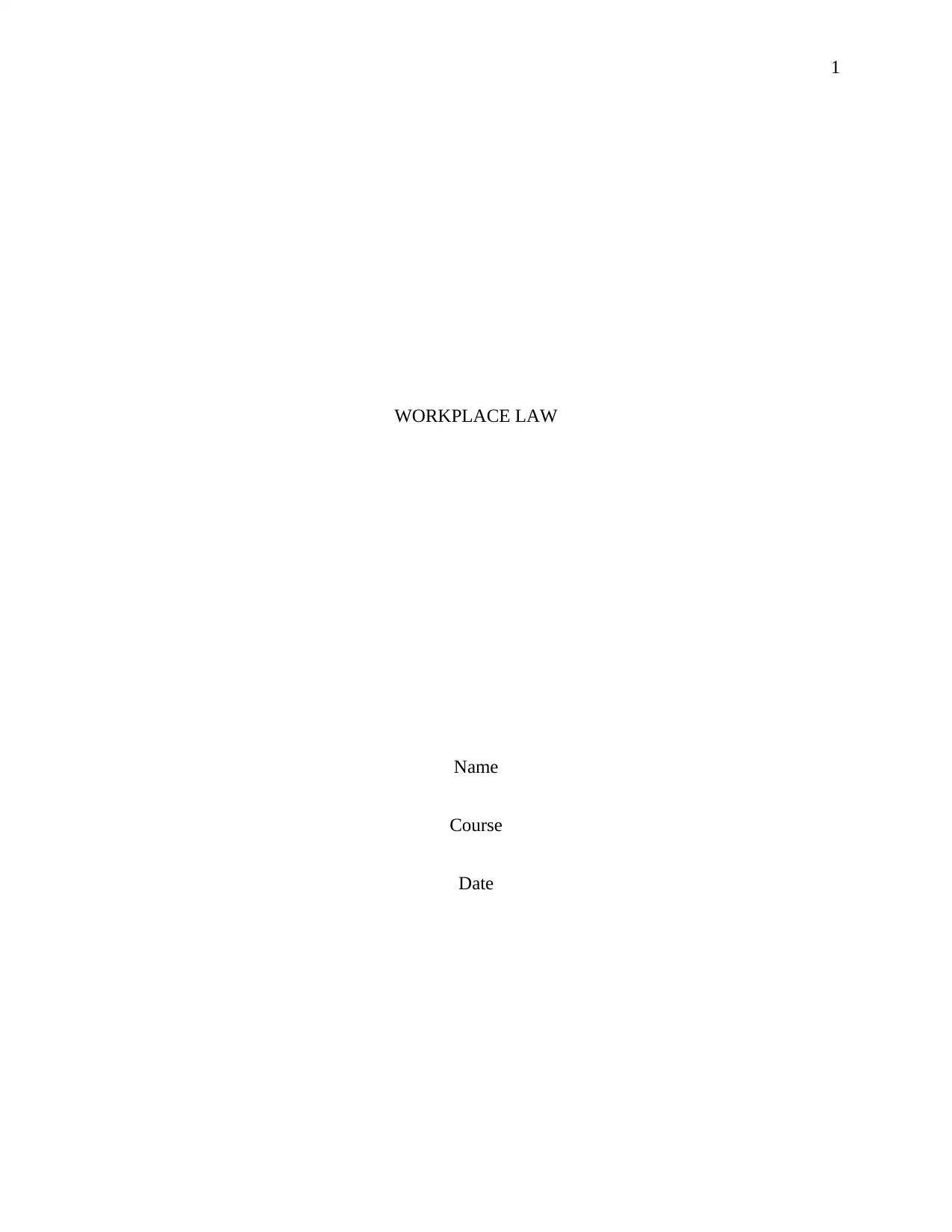
1
WORKPLACE LAW
Name
Course
Date
WORKPLACE LAW
Name
Course
Date
Paraphrase This Document
Need a fresh take? Get an instant paraphrase of this document with our AI Paraphraser
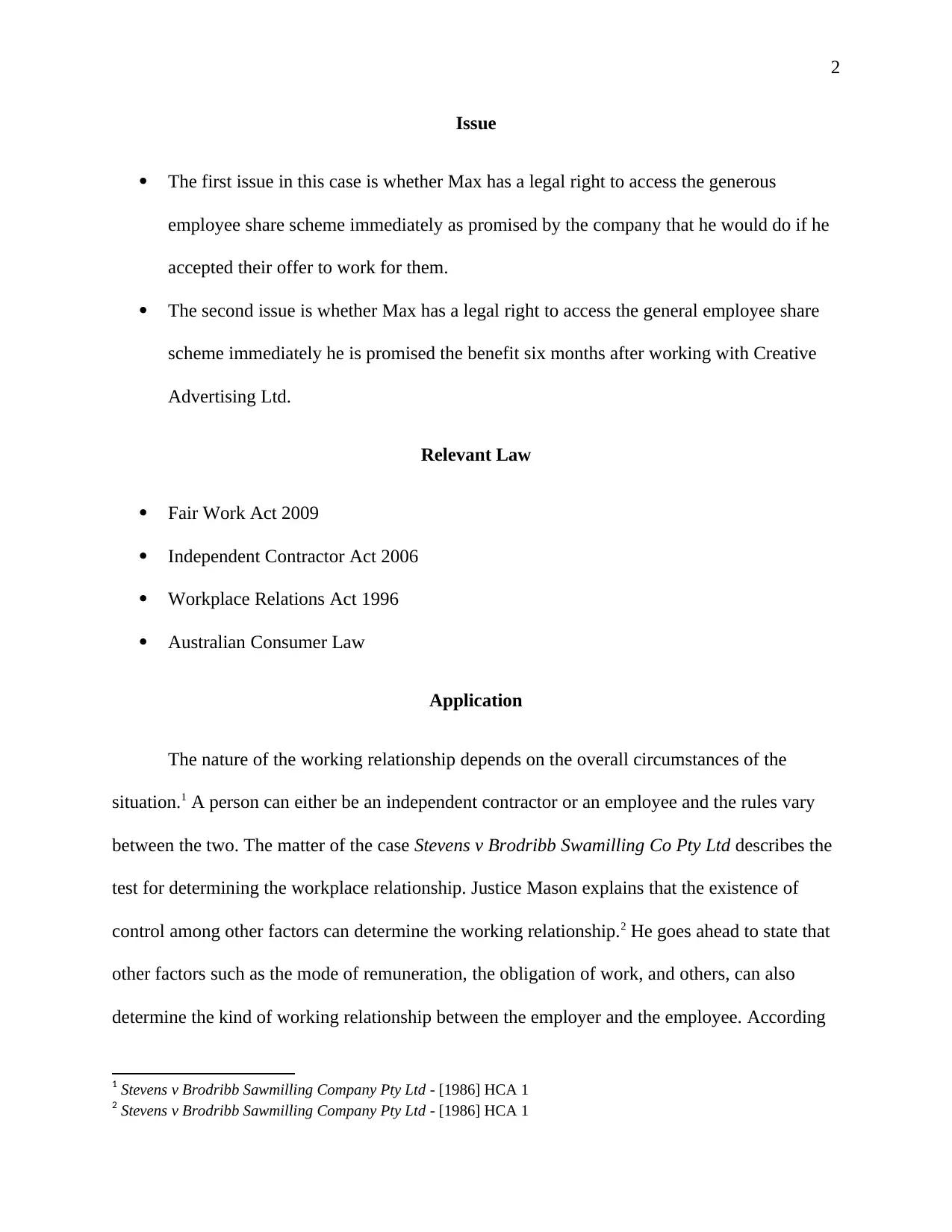
2
Issue
The first issue in this case is whether Max has a legal right to access the generous
employee share scheme immediately as promised by the company that he would do if he
accepted their offer to work for them.
The second issue is whether Max has a legal right to access the general employee share
scheme immediately he is promised the benefit six months after working with Creative
Advertising Ltd.
Relevant Law
Fair Work Act 2009
Independent Contractor Act 2006
Workplace Relations Act 1996
Australian Consumer Law
Application
The nature of the working relationship depends on the overall circumstances of the
situation.1 A person can either be an independent contractor or an employee and the rules vary
between the two. The matter of the case Stevens v Brodribb Swamilling Co Pty Ltd describes the
test for determining the workplace relationship. Justice Mason explains that the existence of
control among other factors can determine the working relationship.2 He goes ahead to state that
other factors such as the mode of remuneration, the obligation of work, and others, can also
determine the kind of working relationship between the employer and the employee. According
1 Stevens v Brodribb Sawmilling Company Pty Ltd - [1986] HCA 1
2 Stevens v Brodribb Sawmilling Company Pty Ltd - [1986] HCA 1
Issue
The first issue in this case is whether Max has a legal right to access the generous
employee share scheme immediately as promised by the company that he would do if he
accepted their offer to work for them.
The second issue is whether Max has a legal right to access the general employee share
scheme immediately he is promised the benefit six months after working with Creative
Advertising Ltd.
Relevant Law
Fair Work Act 2009
Independent Contractor Act 2006
Workplace Relations Act 1996
Australian Consumer Law
Application
The nature of the working relationship depends on the overall circumstances of the
situation.1 A person can either be an independent contractor or an employee and the rules vary
between the two. The matter of the case Stevens v Brodribb Swamilling Co Pty Ltd describes the
test for determining the workplace relationship. Justice Mason explains that the existence of
control among other factors can determine the working relationship.2 He goes ahead to state that
other factors such as the mode of remuneration, the obligation of work, and others, can also
determine the kind of working relationship between the employer and the employee. According
1 Stevens v Brodribb Sawmilling Company Pty Ltd - [1986] HCA 1
2 Stevens v Brodribb Sawmilling Company Pty Ltd - [1986] HCA 1
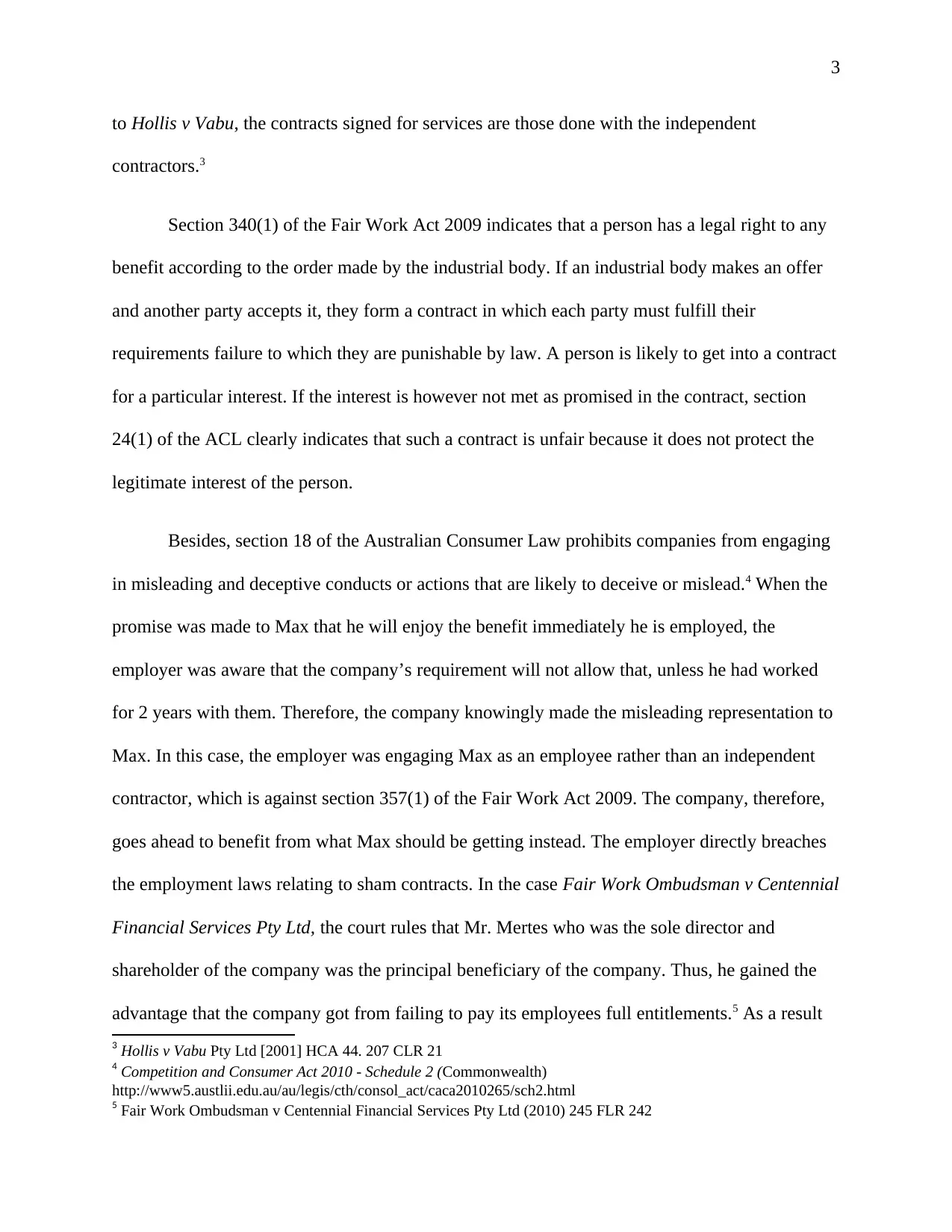
3
to Hollis v Vabu, the contracts signed for services are those done with the independent
contractors.3
Section 340(1) of the Fair Work Act 2009 indicates that a person has a legal right to any
benefit according to the order made by the industrial body. If an industrial body makes an offer
and another party accepts it, they form a contract in which each party must fulfill their
requirements failure to which they are punishable by law. A person is likely to get into a contract
for a particular interest. If the interest is however not met as promised in the contract, section
24(1) of the ACL clearly indicates that such a contract is unfair because it does not protect the
legitimate interest of the person.
Besides, section 18 of the Australian Consumer Law prohibits companies from engaging
in misleading and deceptive conducts or actions that are likely to deceive or mislead.4 When the
promise was made to Max that he will enjoy the benefit immediately he is employed, the
employer was aware that the company’s requirement will not allow that, unless he had worked
for 2 years with them. Therefore, the company knowingly made the misleading representation to
Max. In this case, the employer was engaging Max as an employee rather than an independent
contractor, which is against section 357(1) of the Fair Work Act 2009. The company, therefore,
goes ahead to benefit from what Max should be getting instead. The employer directly breaches
the employment laws relating to sham contracts. In the case Fair Work Ombudsman v Centennial
Financial Services Pty Ltd, the court rules that Mr. Mertes who was the sole director and
shareholder of the company was the principal beneficiary of the company. Thus, he gained the
advantage that the company got from failing to pay its employees full entitlements.5 As a result
3 Hollis v Vabu Pty Ltd [2001] HCA 44. 207 CLR 21
4 Competition and Consumer Act 2010 - Schedule 2 (Commonwealth)
http://www5.austlii.edu.au/au/legis/cth/consol_act/caca2010265/sch2.html
5 Fair Work Ombudsman v Centennial Financial Services Pty Ltd (2010) 245 FLR 242
to Hollis v Vabu, the contracts signed for services are those done with the independent
contractors.3
Section 340(1) of the Fair Work Act 2009 indicates that a person has a legal right to any
benefit according to the order made by the industrial body. If an industrial body makes an offer
and another party accepts it, they form a contract in which each party must fulfill their
requirements failure to which they are punishable by law. A person is likely to get into a contract
for a particular interest. If the interest is however not met as promised in the contract, section
24(1) of the ACL clearly indicates that such a contract is unfair because it does not protect the
legitimate interest of the person.
Besides, section 18 of the Australian Consumer Law prohibits companies from engaging
in misleading and deceptive conducts or actions that are likely to deceive or mislead.4 When the
promise was made to Max that he will enjoy the benefit immediately he is employed, the
employer was aware that the company’s requirement will not allow that, unless he had worked
for 2 years with them. Therefore, the company knowingly made the misleading representation to
Max. In this case, the employer was engaging Max as an employee rather than an independent
contractor, which is against section 357(1) of the Fair Work Act 2009. The company, therefore,
goes ahead to benefit from what Max should be getting instead. The employer directly breaches
the employment laws relating to sham contracts. In the case Fair Work Ombudsman v Centennial
Financial Services Pty Ltd, the court rules that Mr. Mertes who was the sole director and
shareholder of the company was the principal beneficiary of the company. Thus, he gained the
advantage that the company got from failing to pay its employees full entitlements.5 As a result
3 Hollis v Vabu Pty Ltd [2001] HCA 44. 207 CLR 21
4 Competition and Consumer Act 2010 - Schedule 2 (Commonwealth)
http://www5.austlii.edu.au/au/legis/cth/consol_act/caca2010265/sch2.html
5 Fair Work Ombudsman v Centennial Financial Services Pty Ltd (2010) 245 FLR 242
⊘ This is a preview!⊘
Do you want full access?
Subscribe today to unlock all pages.

Trusted by 1+ million students worldwide
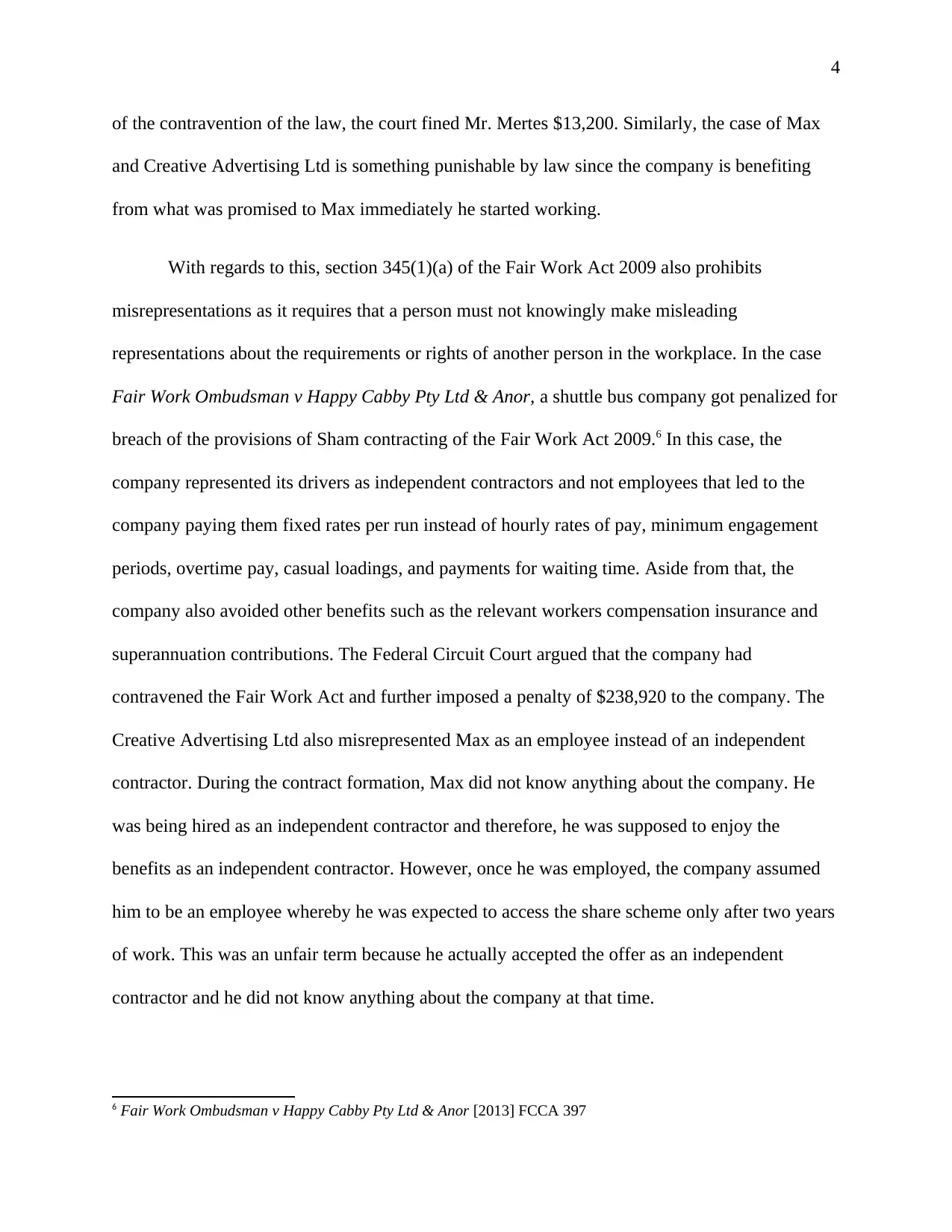
4
of the contravention of the law, the court fined Mr. Mertes $13,200. Similarly, the case of Max
and Creative Advertising Ltd is something punishable by law since the company is benefiting
from what was promised to Max immediately he started working.
With regards to this, section 345(1)(a) of the Fair Work Act 2009 also prohibits
misrepresentations as it requires that a person must not knowingly make misleading
representations about the requirements or rights of another person in the workplace. In the case
Fair Work Ombudsman v Happy Cabby Pty Ltd & Anor, a shuttle bus company got penalized for
breach of the provisions of Sham contracting of the Fair Work Act 2009.6 In this case, the
company represented its drivers as independent contractors and not employees that led to the
company paying them fixed rates per run instead of hourly rates of pay, minimum engagement
periods, overtime pay, casual loadings, and payments for waiting time. Aside from that, the
company also avoided other benefits such as the relevant workers compensation insurance and
superannuation contributions. The Federal Circuit Court argued that the company had
contravened the Fair Work Act and further imposed a penalty of $238,920 to the company. The
Creative Advertising Ltd also misrepresented Max as an employee instead of an independent
contractor. During the contract formation, Max did not know anything about the company. He
was being hired as an independent contractor and therefore, he was supposed to enjoy the
benefits as an independent contractor. However, once he was employed, the company assumed
him to be an employee whereby he was expected to access the share scheme only after two years
of work. This was an unfair term because he actually accepted the offer as an independent
contractor and he did not know anything about the company at that time.
6 Fair Work Ombudsman v Happy Cabby Pty Ltd & Anor [2013] FCCA 397
of the contravention of the law, the court fined Mr. Mertes $13,200. Similarly, the case of Max
and Creative Advertising Ltd is something punishable by law since the company is benefiting
from what was promised to Max immediately he started working.
With regards to this, section 345(1)(a) of the Fair Work Act 2009 also prohibits
misrepresentations as it requires that a person must not knowingly make misleading
representations about the requirements or rights of another person in the workplace. In the case
Fair Work Ombudsman v Happy Cabby Pty Ltd & Anor, a shuttle bus company got penalized for
breach of the provisions of Sham contracting of the Fair Work Act 2009.6 In this case, the
company represented its drivers as independent contractors and not employees that led to the
company paying them fixed rates per run instead of hourly rates of pay, minimum engagement
periods, overtime pay, casual loadings, and payments for waiting time. Aside from that, the
company also avoided other benefits such as the relevant workers compensation insurance and
superannuation contributions. The Federal Circuit Court argued that the company had
contravened the Fair Work Act and further imposed a penalty of $238,920 to the company. The
Creative Advertising Ltd also misrepresented Max as an employee instead of an independent
contractor. During the contract formation, Max did not know anything about the company. He
was being hired as an independent contractor and therefore, he was supposed to enjoy the
benefits as an independent contractor. However, once he was employed, the company assumed
him to be an employee whereby he was expected to access the share scheme only after two years
of work. This was an unfair term because he actually accepted the offer as an independent
contractor and he did not know anything about the company at that time.
6 Fair Work Ombudsman v Happy Cabby Pty Ltd & Anor [2013] FCCA 397
Paraphrase This Document
Need a fresh take? Get an instant paraphrase of this document with our AI Paraphraser
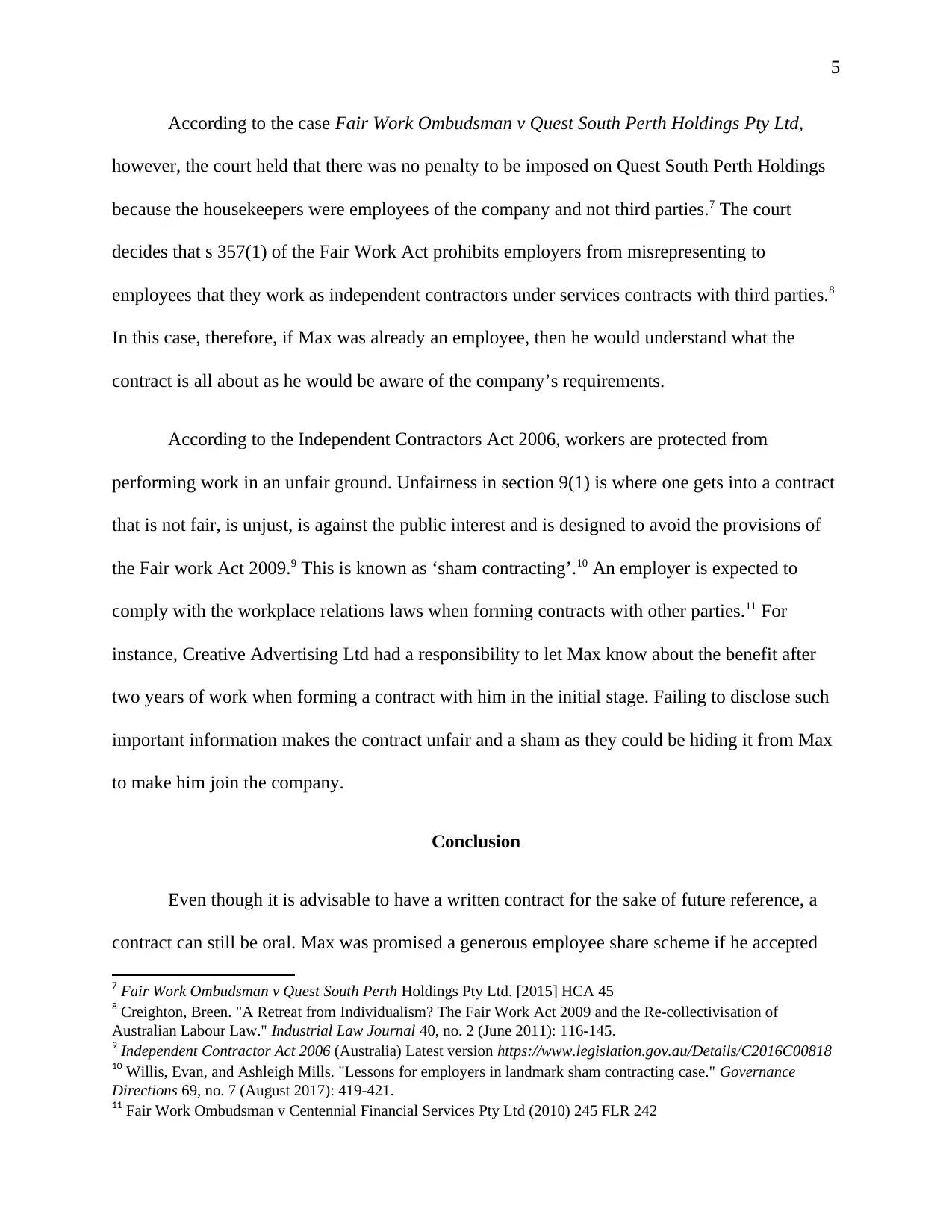
5
According to the case Fair Work Ombudsman v Quest South Perth Holdings Pty Ltd,
however, the court held that there was no penalty to be imposed on Quest South Perth Holdings
because the housekeepers were employees of the company and not third parties.7 The court
decides that s 357(1) of the Fair Work Act prohibits employers from misrepresenting to
employees that they work as independent contractors under services contracts with third parties.8
In this case, therefore, if Max was already an employee, then he would understand what the
contract is all about as he would be aware of the company’s requirements.
According to the Independent Contractors Act 2006, workers are protected from
performing work in an unfair ground. Unfairness in section 9(1) is where one gets into a contract
that is not fair, is unjust, is against the public interest and is designed to avoid the provisions of
the Fair work Act 2009.9 This is known as ‘sham contracting’.10 An employer is expected to
comply with the workplace relations laws when forming contracts with other parties.11 For
instance, Creative Advertising Ltd had a responsibility to let Max know about the benefit after
two years of work when forming a contract with him in the initial stage. Failing to disclose such
important information makes the contract unfair and a sham as they could be hiding it from Max
to make him join the company.
Conclusion
Even though it is advisable to have a written contract for the sake of future reference, a
contract can still be oral. Max was promised a generous employee share scheme if he accepted
7 Fair Work Ombudsman v Quest South Perth Holdings Pty Ltd. [2015] HCA 45
8 Creighton, Breen. "A Retreat from Individualism? The Fair Work Act 2009 and the Re-collectivisation of
Australian Labour Law." Industrial Law Journal 40, no. 2 (June 2011): 116-145.
9 Independent Contractor Act 2006 (Australia) Latest version https://www.legislation.gov.au/Details/C2016C00818
10 Willis, Evan, and Ashleigh Mills. "Lessons for employers in landmark sham contracting case." Governance
Directions 69, no. 7 (August 2017): 419-421.
11 Fair Work Ombudsman v Centennial Financial Services Pty Ltd (2010) 245 FLR 242
According to the case Fair Work Ombudsman v Quest South Perth Holdings Pty Ltd,
however, the court held that there was no penalty to be imposed on Quest South Perth Holdings
because the housekeepers were employees of the company and not third parties.7 The court
decides that s 357(1) of the Fair Work Act prohibits employers from misrepresenting to
employees that they work as independent contractors under services contracts with third parties.8
In this case, therefore, if Max was already an employee, then he would understand what the
contract is all about as he would be aware of the company’s requirements.
According to the Independent Contractors Act 2006, workers are protected from
performing work in an unfair ground. Unfairness in section 9(1) is where one gets into a contract
that is not fair, is unjust, is against the public interest and is designed to avoid the provisions of
the Fair work Act 2009.9 This is known as ‘sham contracting’.10 An employer is expected to
comply with the workplace relations laws when forming contracts with other parties.11 For
instance, Creative Advertising Ltd had a responsibility to let Max know about the benefit after
two years of work when forming a contract with him in the initial stage. Failing to disclose such
important information makes the contract unfair and a sham as they could be hiding it from Max
to make him join the company.
Conclusion
Even though it is advisable to have a written contract for the sake of future reference, a
contract can still be oral. Max was promised a generous employee share scheme if he accepted
7 Fair Work Ombudsman v Quest South Perth Holdings Pty Ltd. [2015] HCA 45
8 Creighton, Breen. "A Retreat from Individualism? The Fair Work Act 2009 and the Re-collectivisation of
Australian Labour Law." Industrial Law Journal 40, no. 2 (June 2011): 116-145.
9 Independent Contractor Act 2006 (Australia) Latest version https://www.legislation.gov.au/Details/C2016C00818
10 Willis, Evan, and Ashleigh Mills. "Lessons for employers in landmark sham contracting case." Governance
Directions 69, no. 7 (August 2017): 419-421.
11 Fair Work Ombudsman v Centennial Financial Services Pty Ltd (2010) 245 FLR 242
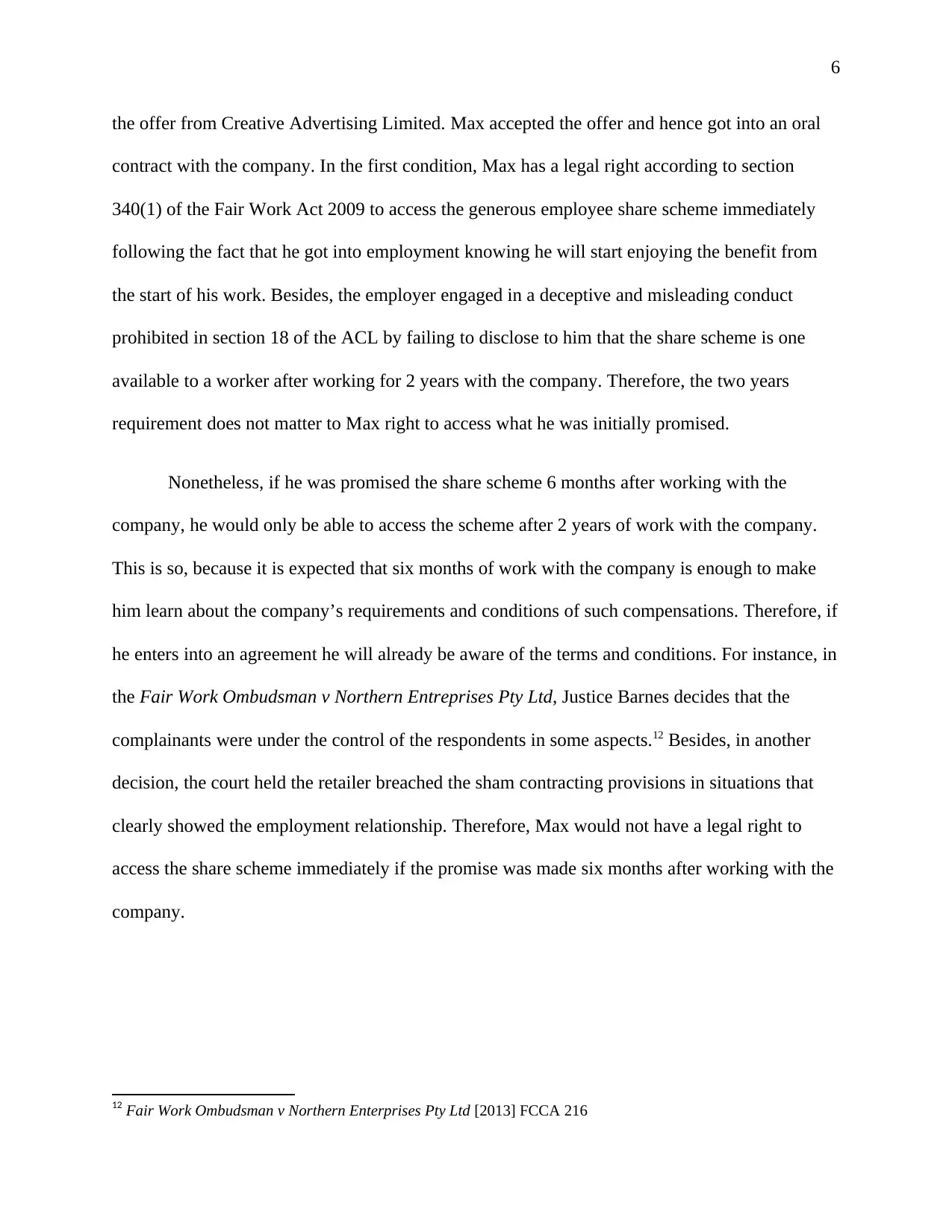
6
the offer from Creative Advertising Limited. Max accepted the offer and hence got into an oral
contract with the company. In the first condition, Max has a legal right according to section
340(1) of the Fair Work Act 2009 to access the generous employee share scheme immediately
following the fact that he got into employment knowing he will start enjoying the benefit from
the start of his work. Besides, the employer engaged in a deceptive and misleading conduct
prohibited in section 18 of the ACL by failing to disclose to him that the share scheme is one
available to a worker after working for 2 years with the company. Therefore, the two years
requirement does not matter to Max right to access what he was initially promised.
Nonetheless, if he was promised the share scheme 6 months after working with the
company, he would only be able to access the scheme after 2 years of work with the company.
This is so, because it is expected that six months of work with the company is enough to make
him learn about the company’s requirements and conditions of such compensations. Therefore, if
he enters into an agreement he will already be aware of the terms and conditions. For instance, in
the Fair Work Ombudsman v Northern Entreprises Pty Ltd, Justice Barnes decides that the
complainants were under the control of the respondents in some aspects.12 Besides, in another
decision, the court held the retailer breached the sham contracting provisions in situations that
clearly showed the employment relationship. Therefore, Max would not have a legal right to
access the share scheme immediately if the promise was made six months after working with the
company.
12 Fair Work Ombudsman v Northern Enterprises Pty Ltd [2013] FCCA 216
the offer from Creative Advertising Limited. Max accepted the offer and hence got into an oral
contract with the company. In the first condition, Max has a legal right according to section
340(1) of the Fair Work Act 2009 to access the generous employee share scheme immediately
following the fact that he got into employment knowing he will start enjoying the benefit from
the start of his work. Besides, the employer engaged in a deceptive and misleading conduct
prohibited in section 18 of the ACL by failing to disclose to him that the share scheme is one
available to a worker after working for 2 years with the company. Therefore, the two years
requirement does not matter to Max right to access what he was initially promised.
Nonetheless, if he was promised the share scheme 6 months after working with the
company, he would only be able to access the scheme after 2 years of work with the company.
This is so, because it is expected that six months of work with the company is enough to make
him learn about the company’s requirements and conditions of such compensations. Therefore, if
he enters into an agreement he will already be aware of the terms and conditions. For instance, in
the Fair Work Ombudsman v Northern Entreprises Pty Ltd, Justice Barnes decides that the
complainants were under the control of the respondents in some aspects.12 Besides, in another
decision, the court held the retailer breached the sham contracting provisions in situations that
clearly showed the employment relationship. Therefore, Max would not have a legal right to
access the share scheme immediately if the promise was made six months after working with the
company.
12 Fair Work Ombudsman v Northern Enterprises Pty Ltd [2013] FCCA 216
⊘ This is a preview!⊘
Do you want full access?
Subscribe today to unlock all pages.

Trusted by 1+ million students worldwide
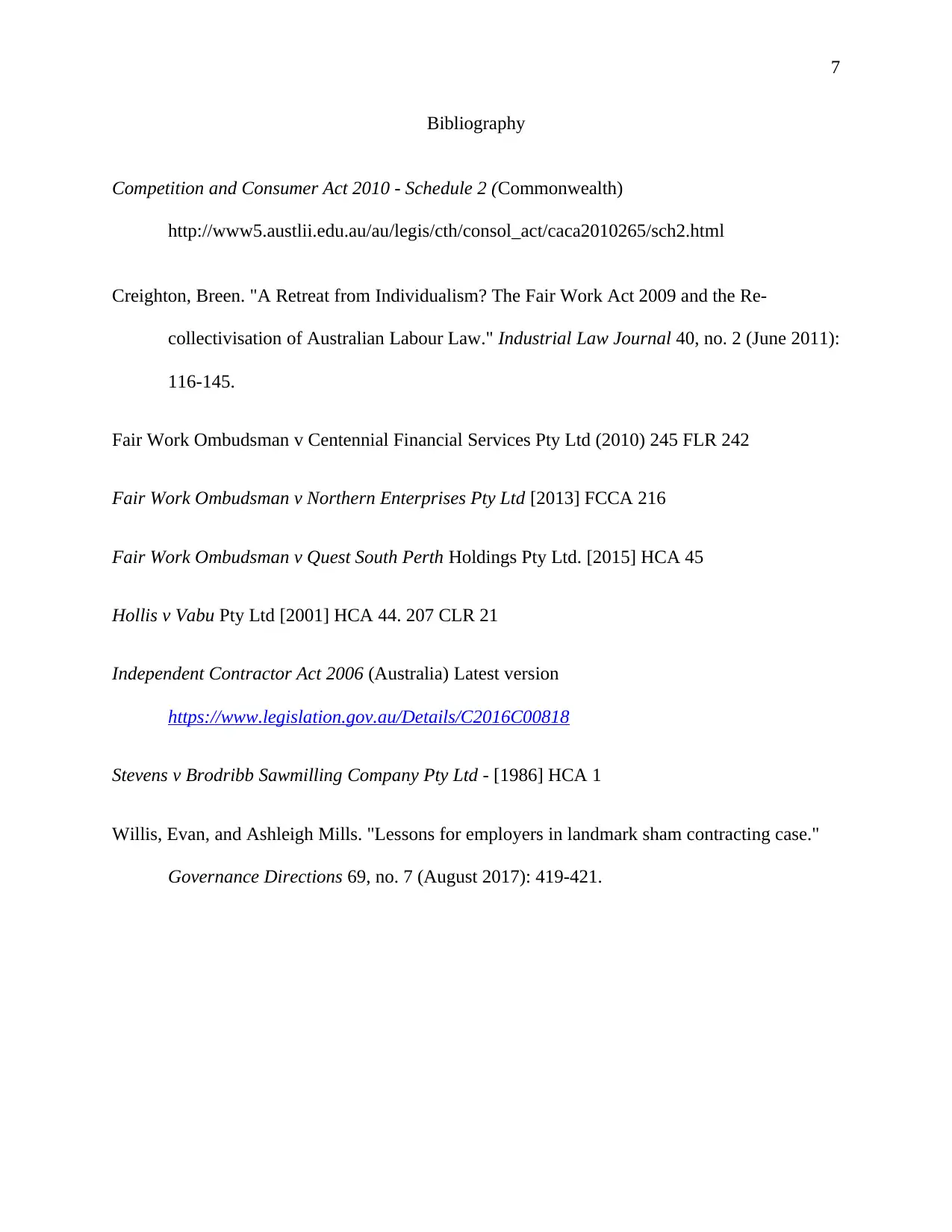
7
Bibliography
Competition and Consumer Act 2010 - Schedule 2 (Commonwealth)
http://www5.austlii.edu.au/au/legis/cth/consol_act/caca2010265/sch2.html
Creighton, Breen. "A Retreat from Individualism? The Fair Work Act 2009 and the Re-
collectivisation of Australian Labour Law." Industrial Law Journal 40, no. 2 (June 2011):
116-145.
Fair Work Ombudsman v Centennial Financial Services Pty Ltd (2010) 245 FLR 242
Fair Work Ombudsman v Northern Enterprises Pty Ltd [2013] FCCA 216
Fair Work Ombudsman v Quest South Perth Holdings Pty Ltd. [2015] HCA 45
Hollis v Vabu Pty Ltd [2001] HCA 44. 207 CLR 21
Independent Contractor Act 2006 (Australia) Latest version
https://www.legislation.gov.au/Details/C2016C00818
Stevens v Brodribb Sawmilling Company Pty Ltd - [1986] HCA 1
Willis, Evan, and Ashleigh Mills. "Lessons for employers in landmark sham contracting case."
Governance Directions 69, no. 7 (August 2017): 419-421.
Bibliography
Competition and Consumer Act 2010 - Schedule 2 (Commonwealth)
http://www5.austlii.edu.au/au/legis/cth/consol_act/caca2010265/sch2.html
Creighton, Breen. "A Retreat from Individualism? The Fair Work Act 2009 and the Re-
collectivisation of Australian Labour Law." Industrial Law Journal 40, no. 2 (June 2011):
116-145.
Fair Work Ombudsman v Centennial Financial Services Pty Ltd (2010) 245 FLR 242
Fair Work Ombudsman v Northern Enterprises Pty Ltd [2013] FCCA 216
Fair Work Ombudsman v Quest South Perth Holdings Pty Ltd. [2015] HCA 45
Hollis v Vabu Pty Ltd [2001] HCA 44. 207 CLR 21
Independent Contractor Act 2006 (Australia) Latest version
https://www.legislation.gov.au/Details/C2016C00818
Stevens v Brodribb Sawmilling Company Pty Ltd - [1986] HCA 1
Willis, Evan, and Ashleigh Mills. "Lessons for employers in landmark sham contracting case."
Governance Directions 69, no. 7 (August 2017): 419-421.
1 out of 7
Related Documents
Your All-in-One AI-Powered Toolkit for Academic Success.
+13062052269
info@desklib.com
Available 24*7 on WhatsApp / Email
![[object Object]](/_next/static/media/star-bottom.7253800d.svg)
Unlock your academic potential
Copyright © 2020–2025 A2Z Services. All Rights Reserved. Developed and managed by ZUCOL.





